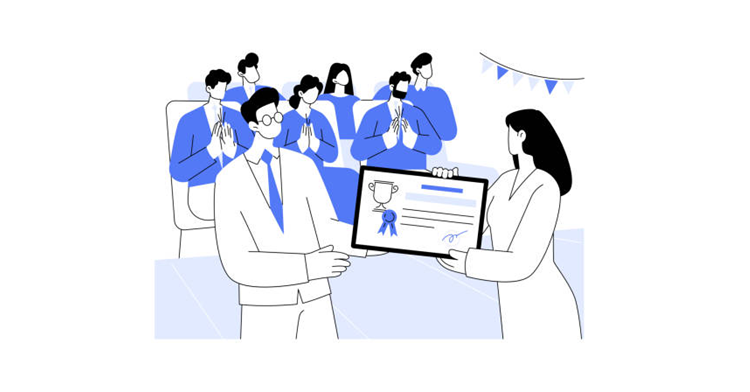1. Cost Misconception: Many believe recognition platforms are too expensive, but affordable SaaS-based solutions with flexible pricing are available, making them cost-effective.
2. Implementation Misconception: Organizations think platform implementation is complex and time-consuming, but modern platforms offer easy integration, quick setup, and comprehensive support.
3. Effectiveness Misconception: Some organizations feel their current offline programs are sufficient, but these can be cumbersome for remote or hybrid workforces, while digital platforms offer greater flexibility and efficiency.
4. Personal Touch Misconception: Some fear that digitalization will lose the personal touch, but new platform features like gamification and social recognition enhance engagement and maintain a human element.
Digital employee recognition programs can drive higher employee engagement and motivation than traditional offline recognition systems. However, despite the benefits of digitizing employee recognition, several organizations still harbor misconceptions about employee recognition platforms.
Read: Key Reasons to Digitize an Employee Recognition Program
So, in this article, we look at the common misconceptions about employee recognition platforms and the truth behind them:
1. Employee recognition platforms are too expensive
2. Platform implementation is complicated and time-consuming
3. The current offline program works smoothly without any significant issues
4. Digitalization will result in loss of personal touch
5. The current program is perfect for the organization’s needs


A common perception in organizations is that a decent recognition platform requires a significant financial investment.
Also, organizations must invest in training their HR teams to use the platform efficiently, which can add to the overall expenses of implementing such platforms.
Hence, organizations fear that an expensive employee recognition program might eat into their overall program budget and leave little in the form of employee rewards.

Several cloud-based employee recognition platforms operate on a Software-as-a-Service (SaaS) model and do not require upfront investment.
These platforms also have flexible pricing plans that are based on the actual features and functionalities utilized and the number of active users.
With some research, organizations can easily find a platform that fits their budgets.
They can opt for monthly subscription plans that work on a pay-as-you-go model, making it very affordable.

Organizations often believe setting up employee recognition platforms is complicated and time-consuming.
Hence, they feel it takes significant time and effort to customize the platform to their requirements.
Also, organizations feel uncertain about the smooth integration of the platform with other technology platforms at the workplace.

The new generation SaaS-based employee recognition platforms are easy to implement and integrate with other applications at the workplace.
A good platform vendor would provide a comprehensive framework for implementation, complete with project plans, checklists, and templates to speed up the entire process.

Most organizations do not want to fix processes that aren’t broken.
Hence, they would like to believe that the current offline employee recognition processes are efficient and have few issues.

Offline recognition programs are quite cumbersome to recognize employees who are working remotely, no matter how small or big the organization is.
Hence, organizations must consider seriously upgrading their offline programs to digital ones.

Another common objection against employee recognition software is that it results in the loss of personal touch from managers.
Hence, they fear that this can turn recognition into a mere formality.
This is especially true for smaller organizations where all employees operate from the same workplace.

Modern employee recognition platforms have cutting-edge features such as gamification, social recognition, bonus points, etc.
These features help in enhancing the employee engagement levels thereby significantly increasing their impact.
These platforms also integrate with internal collaboration platforms such as Slack and MS Teams and social media platforms such as LinkedIn and Facebook.

Also, several organizations feel that the current programs meet their requirements perfectly as they are like well-oiled machines running smoothly over the years without many hiccups.
Hence, they are reluctant to explore other options and industry best practices.

These platforms are highly configurable, making them extremely flexible to meet the current and future requirements of the organizations as well as the changing expectations of the workforce over a significant period.
They also provide dashboards and analytics, making it easier for organizations to monitor the program’s key metrics and take timely action.
It is quite apparent that the common misconceptions about employee recognition platforms are not real, but have more to do with resistance to change. Hence, organizations should instead consider the benefits of going digital and focus on evaluating platforms that are best for them.

Lead author: Sagar Chaudhuri, the Co-Founder and CEO of HiFives. He is an HR Tech Evangelist with over 25 years of corporate and entrepreneurship experience. In the past, Sagar has worked in leadership roles with companies such as Genpact, Infosys, and ICICI Bank. He has an engineering degree from IIT Kharagpur and an MBA from IIM Lucknow. Connect on LinkedIn
To get regular updates on the latest HiFives blogs, follow us on Twitter (@MyHiFives)